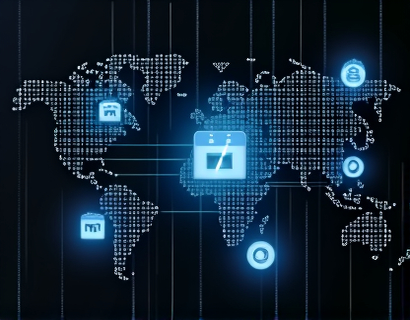Blockchain-Powered Asset Tokenization: Bridging Physical Assets with Digital Liquidity
In the evolving landscape of finance and asset management, the integration of blockchain technology has emerged as a transformative force. One of the most promising applications of blockchain is asset tokenization, a process that bridges the gap between physical assets and the digital world. This innovative approach not only enhances liquidity and market accessibility but also revolutionizes the way assets are managed and traded. By leveraging the immutable and transparent nature of blockchain, asset tokenization offers a secure and efficient solution for asset holders and investors alike.
Understanding Asset Tokenization
Asset tokenization involves converting real-world assets into digital tokens on a blockchain network. These tokens represent a fraction or the entirety of the underlying asset, such as real estate, art, machinery, or even intangible assets like intellectual property. The process begins with the identification and valuation of the asset, followed by the creation of a smart contract that defines the rules and parameters of the token. These tokens can then be bought, sold, or traded on blockchain-based platforms, providing a level of liquidity that was previously unattainable for many physical assets.
Enhancing Liquidity
Traditional assets often suffer from illiquidity, meaning they cannot be easily converted into cash without significant loss in value. Asset tokenization changes this dynamic by allowing assets to be divided into smaller, tradable units. This fractional ownership model makes it possible for a broader range of investors to participate in the market. For instance, a piece of commercial real estate valued at millions can be tokenized into thousands of tokens, each representing a small fraction of the property. This democratizes access to high-value assets, enabling individual investors to own parts of these properties without the need for substantial upfront capital.
Increasing Market Accessibility
The accessibility of asset markets is significantly enhanced through tokenization. Traditional asset investment requires substantial resources and often involves complex legal and regulatory processes. Tokenization simplifies these barriers by leveraging blockchain's decentralized and transparent nature. Investors can now access a diverse portfolio of assets with ease, using digital wallets and online platforms. This reduction in entry barriers fosters a more inclusive financial ecosystem, where individuals with varying levels of investment capacity can participate and benefit from the growth of various asset classes.
Improving Transparency and Trust
Blockchain technology's core strength lies in its ability to provide transparency and immutability. Every transaction involving asset tokens is recorded on the blockchain, creating a tamper-proof ledger that all participants can access. This transparency builds trust among investors and asset holders, reducing the risk of fraud and errors. Smart contracts, which automate and enforce the terms of the asset agreement, further enhance the reliability of the process. These self-executing contracts reduce the need for intermediaries, lowering transaction costs and speeding up the trading process.
Use Cases of Asset Tokenization
The applications of asset tokenization are vast and varied, spanning multiple industries. In real estate, tokenization can facilitate fractional ownership of properties, making it easier for investors to diversify their portfolios. For example, a commercial building can be tokenized, allowing multiple investors to own shares of the property and benefit from its rental income and appreciation in value. In the art world, tokenization can verify the authenticity and provenance of artworks, making it easier to buy, sell, and trade high-value pieces. This not only protects artists and collectors but also opens new markets for art investment.
In the realm of infrastructure, asset tokenization can attract more investors to large-scale projects such as bridges, highways, and energy plants. By tokenizing these assets, governments and private entities can raise capital more efficiently and manage the assets more effectively. In the technology sector, intellectual property rights can be tokenized, providing creators with new ways to monetize their work and ensuring proper attribution and compensation.
Challenges and Considerations
Despite its numerous benefits, asset tokenization is not without challenges. Regulatory uncertainty remains a significant hurdle, as different jurisdictions have varying approaches to blockchain and tokenized assets. Compliance with securities laws and anti-money laundering regulations is crucial to ensure the legitimacy and sustainability of tokenization projects. Additionally, the technical complexity of blockchain and smart contracts requires a skilled workforce to develop and maintain these systems. Education and training programs are essential to build the necessary expertise in this emerging field.
Another consideration is the volatility of tokenized assets, which can be influenced by market sentiment and the underlying asset's performance. Investors must conduct thorough due diligence and risk assessment before participating in tokenized asset markets. Furthermore, the environmental impact of blockchain, particularly proof-of-work consensus mechanisms, is a growing concern. Adopting more sustainable blockchain solutions, such as proof-of-stake, can help mitigate this issue.
Future Prospects
The future of asset tokenization looks promising, with ongoing advancements in blockchain technology addressing current challenges. The development of more efficient consensus algorithms and the integration of off-chain solutions can enhance scalability and reduce transaction costs. Regulatory frameworks are also evolving, with many countries recognizing the potential of blockchain and taking steps to create supportive environments for tokenization projects. As the ecosystem matures, we can expect increased adoption and innovation, further solidifying the role of asset tokenization in the financial landscape.
In conclusion, blockchain-powered asset tokenization represents a significant leap forward in asset management. By bridging the gap between physical and digital worlds, it enhances liquidity, increases market accessibility, and improves transparency and trust. As the technology continues to evolve, it will play an increasingly vital role in shaping the future of finance and beyond.










































